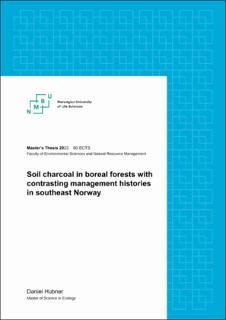| dc.description.abstract | Macroscopic charcoal particles in the soil of boreal forests provide a record of local-scale fire history. They also serve as a long-lived carbon sink and have a positive influence on soil function. However, the distribution of soil charcoal is extremely patchy at small spatial scales, which complicates efforts to quantify the soil charcoal pool precisely. In this project, I investigated the size, variability, parent species composition, and environmental relationships of the soil charcoal pool in boreal forests with contrasting management histories in southeast Norway.
My project is based upon the mass and origin species of charcoal particles found in 113 soil cores collected from 10 pairs of spruce forest plots. The paired plots are as similar as possible except for their past management; one plot in each pair has historically been clear-cut and the other is near-natural. I analyzed 1) the overall size, variability, and species composition of the soil charcoal pool in the project region; 2) differences in the charcoal pools of the paired plots and consequent implications for their site histories; and 3) modeled relationships between the charcoal pool and metrics of climate, terrain, and contemporary forest characteristics. I found an overall mean charcoal content of 168 (± 36) g/m2, which aligns with past studies in the region; however, within-plot spatial variability was very high, and the plot-level estimates therefore lacked precision. The soil charcoal pool was dominated by spruce charcoal (contrasting with previous results that found pine charcoal to be dominant even at spruce forest sites, as spruce forests became dominant in the region relatively recently in the late Holocene).
There was no overall difference in charcoal content between clear-cut and near-natural plots, but three individual sites exhibited significant differences between their paired plots, and I assessed the potential implications for the site histories of these plots. Finally, I found no relationships between the soil charcoal pool and any climate or terrain metrics, likely due to issues of scale; however, I found a positive relationship between charcoal occurrence and the proportion of (and proximity to) pine forest in the surrounding landscape.
My findings emphasize the importance of fine-scale spatial effects in controlling the soil charcoal pool. Intensive sampling is necessary in order to precisely estimate the average soil charcoal stock even on the scale of a single forest stand; similarly, fine-scale measurement of environmental variables is necessary in order to meaningfully analyze their relationships with the soil charcoal pool. In spite of this, my results identified a significant relationship between charcoal occurrence and forest composition at a broader spatial scale, possibly reflecting an influence of landscape-level species composition on stand-level fire regimes. | |
